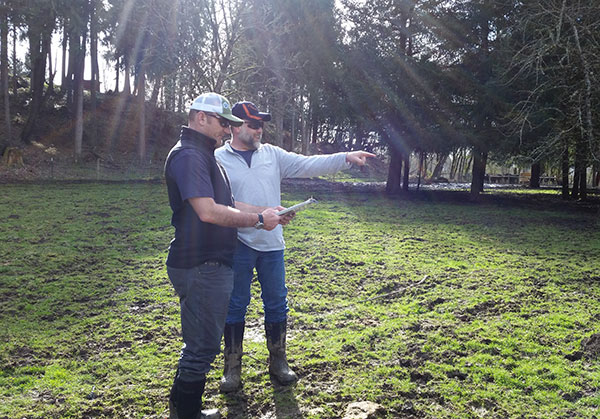
CLIP is a cost-share program designed to help landowners fix natural resource issues on private properties, including private residences, businesses, and properties owned or managed by non-profits.
Rural CLIP addresses working lands issues such as erosion, invasive species, water conservation and mud management.
Urban CLIP works with non-agricultural landowners inside the Urban Growth Boundary to implement vegetation-based erosion control, remove invasive species and restore natural habitat along streams, and manage storm water with rain gardens.
Is my project eligible for consideration?
Projects must be on private property inside EMSWCD’s service area, which is all Multnomah County east of the Willamette River. CLIP funding is available for new, voluntary projects only, and cannot be used for maintenance or legally/regulatorily required activities.
Please note: Eligibility for consideration is not a guarantee of funding.
Rural CLIP works with:
- Rural acreage, hobby farms, and small woodlot owners
- Commercial farms and nurseries
- Land managers or renters of agricultural land (with landowner’s consent)
Urban CLIP works inside the Urban Growth Boundary:
- Private properties directly adjacent to or containing a wetland, stream, or river may be eligible for vegetative erosion control (not including bank stabilization), habitat restoration projects to increase stream shading, and stormwater management.
- Private properties within Gresham’s Downspout Disconnection zone may be eligible for stormwater management.
- Low-income multi-family housing units may be eligible for assistance on a case by case basis.
*Note: Urban CLIP’s purpose is to improve water quality and stream-side habitat, and increase stream shading. Restoration plantings cover the full extent of the area from which invasives were removed, and consist primarily of trees and thicket-forming shrubs. Priority is given to large projects with walkable slopes that are contiguous with streams, and where there is a high likelihood of removing all invasives present. CLIP does not fund the removal of individual invasive trees.
How does it work?
- Contact one of our staff (see below) and describe the issue. We will visit your property, assess whether there is a resource concern that we can fund, and help you develop ideas about possible solutions. Staff will explain what practices are eligible for CLIP funding and which are not.
- If the issue and solution you choose are within program guidelines, staff will develop a CLIP project plan and funding proposal for internal review. Sometimes this will involve additional conversations to improve and refine the project before it is finalized. Please note: Internal review may still uncover issues (such as safety concerns) at this stage that can render a project ineligible for funding.
- If the project clears internal review, and once the proposal is finalized, it will be presented to the EMSWCD Board for approval. Proposals are reviewed once a month on an on-going basis.
- Once the proposal is approved and signed by all parties, work can begin. Reimbursements for approved expenses will be distributed as receipts are received.
Please note: Funding is contingent on approval by the Board of Directors.
Ready to get started? Contact our technical staff!
- For Rural CLIP, contact Jeremy Baker:
- jeremy@emswcd.org
- (503) 935-5361
- For Urban CLIP, contact Whitney Bailey:
- whitney@emswcd.org
- (971) 712-3065
